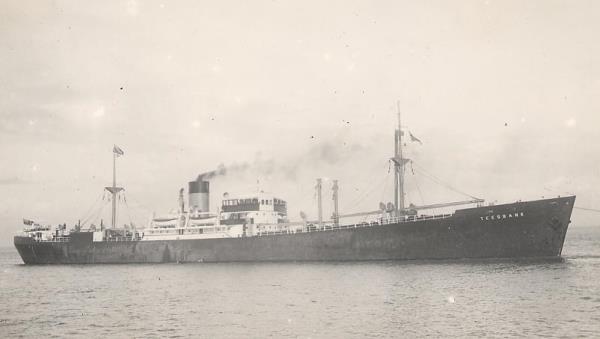Teesbank
British Motor merchant

Photo Courtesy of Library of Contemporary History, Stuttgart
| Name | Teesbank | ||
| Type: | Motor merchant | ||
| Tonnage | 5,136 tons | ||
| Completed | 1937 - William Doxford & Sons Ltd, Sunderland | ||
| Owner | Andrew Weir & Co, London | ||
| Homeport | Glasgow | ||
| Date of attack | 5 Dec 1942 | Nationality: | |
| Fate | Sunk by U-128 (Ulrich Heyse) | ||
| Position | 3° 33'N, 29° 35'W - Grid ER 9814 | ||
| Complement | 62 (1 dead and 61 survivors). | ||
| Convoy | |||
| Route | Port Said - Port Elizabeth (18 Nov) - Georgetown, Demerara | ||
| Cargo | Ballast | ||
| History | Completed in June 1937 | ||
| Notes on event | At 05.46 hours on 5 Dec 1942 the unescorted Teesbank (Master William George Lorains) was hit on the port side in the #5 hold by two G7a torpedoes from U-128 while steaming on a non-evasive course at 13 knots in fine weather about 160 miles north of St. Paul Rocks. The explosions threw a large column of water up, blew the hatches off #5 hold and the derricks over the side and only slightly damaged the deck, but the aerial was carried away and the rigging fouled the emergency aerial so no distress signals could be sent. The engines were shut down immediately as they began to race due to damage to the propeller shaft and water was entering the engine room. While the ship began to settle by the stern with a heavy list to starboard, the most of the 52 crew members and nine gunners (the ship was armed with one 4.7in, one 12pdr, two 20mm and four machine guns) began to abandon ship in the four lifeboats. The U-boat fired a coup de grâce from a stern torpedo tube at 06.00 hours, but missed due to a gyroscope malfunction, so a second was fired ten minutes later that hit on the port side between #4 deep tank and the engine room. The master, chief and second officer, chief engineer and radio officer were still aboard when the G7a torpedo struck and the port aft boat still alongside was swamped by the explosion and violently thrown forward into the other port lifeboat which was extensively damaged. The former was also hit by a large piece of debris that injured two of the Lascars, one of them mortally. Those remaining aboard quickly left in the starboard aft boat in which the emergency wireless set had been lowered. All four boats pulled clear from the sinking ship, the port aft boat around to the starboard side to join the others, while the boat in charge of the second officer pulled ahead and was some distance away when the U-boat approached the group of three boats. The Germans asked questions about the name of the ship, port of departure, destination and cargo to which the chief engineer answered with wrong information, but they learned the correct details when asking the second officer afterwards. The master was taken prisoner by U-128, transferred to U-461 (Stiebler) on 10 December and taken to the POW Camp Milag Nord after being landed at St. Nazaire on 3 Jan 1943. Before the U-boat left, they gave the survivors the distance and course to the coast of Brazil. The Teesbank eventually sank vertically by the stern about 30 minutes after being hit by the coup de grâce. The port forward boat in charge of the chief officer proved to be too badly damaged, so all gear and provisions and nearly all Europeans were transferred to the port aft boat in charge of the third officer that then was occupied by 19 men. The chief officer took over the starboard forward boat in which the master was with 20 men in it. The starboard aft boat held 21 men and was in charge of the second officer. While preparing for sailing they discovered that the emergency wireless set had been damaged or got wet during lowering and was useless. At noon, all boats set sail but soon the port aft boat fell behind as it was a motor boat and the weight of the engine slowed down its progress. Some extra rations were transferred to it by the other boats which then went ahead. These two boats managed to keep together all the time, carrying on for nine and a half days until being picked up by West Maximus in position 01°57S/37°38W on 14 December, after covering a distance of 598 miles. To attract her attention a red smoke float was burned, but a gunner had already spotted their red sails from a distance of about 10 miles. The 41 survivors were landed at Rio de Janeiro on 22 December. At 22.30 hours on 15 December, the 19 survivors in the remaining boat were picked up by East Wales, but she was herself torpedoed and sunk by U-159 (Witte) less than 24 hours later. Nevertheless all men from Teesbank survived, were picked up by the Swedish motor merchant Gullmaren after six days and landed at Natal, Brazil on 23 December. | ||
| On board | We have details of 6 people who were on board. | ||
If you can help us with any additional information on this vessel then please contact us.
